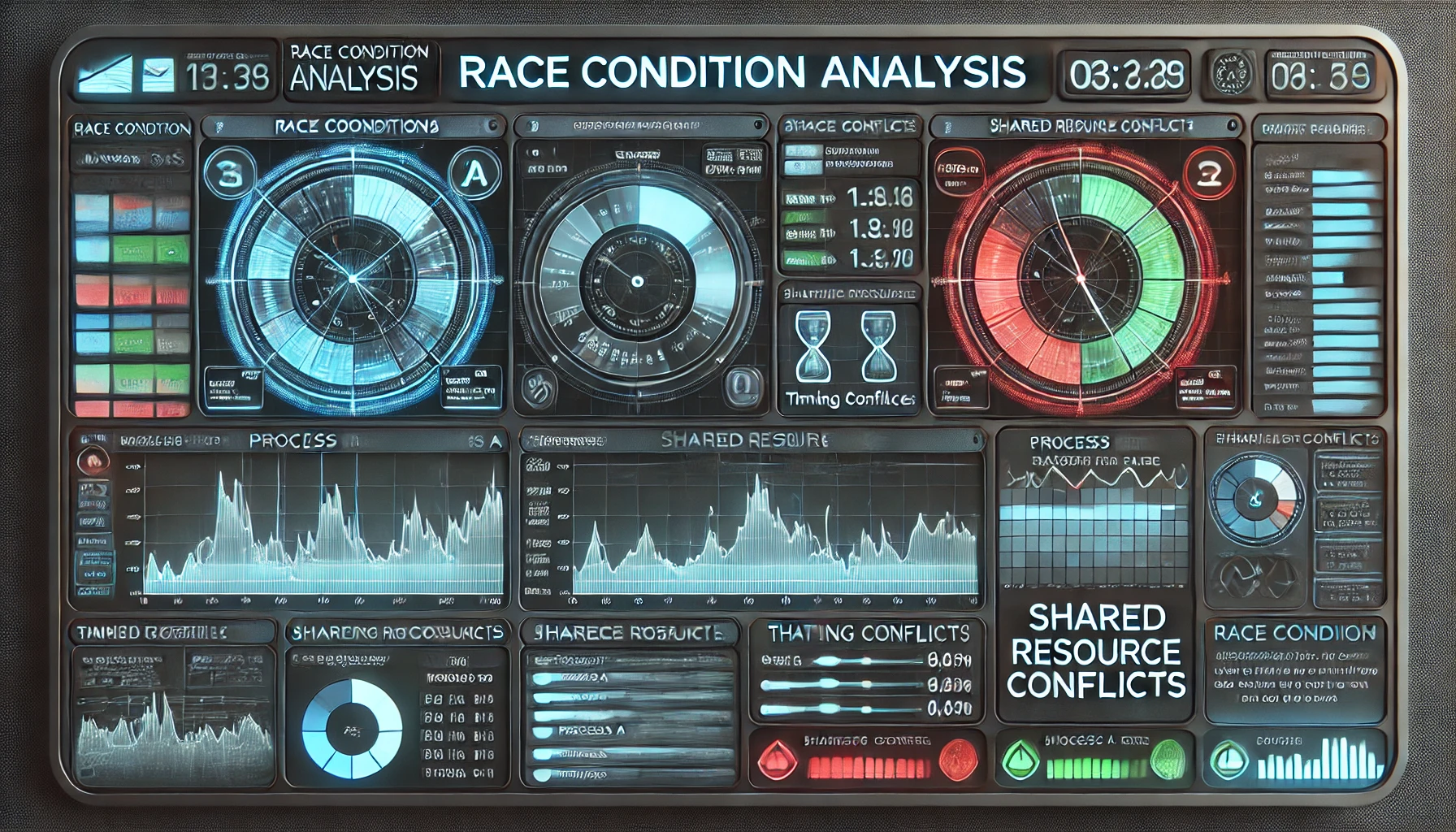What vulnerability occurs when the output of an event depends on ordered or timed outputs?
- Access control problems
- Buffer overflow
- Weaknesses in security practices
- Non-validated input
- Race conditions
The correct answer is Race conditions.
Detailed Explanation on Race Conditions in Cybersecurity

Race conditions occur when the output or behavior of a system depends on the sequence or timing of uncontrollable events. This vulnerability can lead to unpredictable behavior, including system crashes, data corruption, or unauthorized access. It is particularly concerning in concurrent or multi-threaded systems where multiple processes or threads compete to execute simultaneously.
What Are Race Conditions?
A race condition arises in a situation where:
- Two or more processes access shared resources or data.
- The order of execution is critical.
- The correct operation depends on the sequence or timing of these processes.
When the system does not enforce proper synchronization, a malicious actor can exploit these vulnerabilities to perform unauthorized actions.
How Race Conditions Work
- Scenario: Imagine two processes, Process A and Process B, are accessing a shared resource such as a file or a database record.
- Desired Behavior: Process A completes its operation before Process B starts.
- Exploitation: An attacker might manipulate the system to ensure Process B executes prematurely, disrupting the intended order of operations.
This exploitation can lead to:
- Overwriting critical data.
- Gaining unauthorized access to protected resources.
- Triggering unexpected system states.
Common Examples of Race Conditions
1. File System Race Conditions
- Example: Two processes attempt to modify or delete the same file simultaneously. If the file permissions are not checked before access, attackers can replace the file with a malicious version, leading to a privilege escalation attack.
2. Authentication Bypass
- Example: A system temporarily elevates user privileges during specific operations. If an attacker triggers operations concurrently, they might retain elevated privileges indefinitely.
3. Banking and Financial Systems
- Example: Exploiting race conditions during money transfer operations can result in double withdrawals or transfers without actual debits.
4. Memory Allocation
- Example: In concurrent programming, processes might compete for memory allocation. Attackers can force memory leaks or buffer overflows.
Exploitation Techniques
Attackers exploit race conditions through:
- Thread Injection: Inserting malicious threads to disrupt normal execution.
- Delayed Synchronization: Intentionally slowing down one process to allow another to take precedence.
- Rapid Request Injection: Flooding the system with requests to increase the likelihood of exploiting timing discrepancies.
Mitigation Strategies
- Proper Synchronization
- Use mutexes, semaphores, and locks to ensure only one process accesses critical resources at a time.
- Atomic Operations
- Ensure critical operations (e.g., reading and writing a file) are performed as a single, uninterruptible unit.
- Input Validation
- Validate all inputs, even those from trusted sources, to prevent malicious manipulations.
- Access Control
- Implement strict access controls to minimize unauthorized access to shared resources.
- Code Reviews and Testing
- Conduct thorough code reviews and stress testing to identify and address race conditions during development.
Real-World Incidents Involving Race Conditions
- Apple’s “Goto Fail” Bug
- A race condition in Apple’s SSL/TLS implementation allowed attackers to bypass encryption entirely.
- Ethereum Wallet Breach
- A race condition in a multi-signature wallet smart contract allowed attackers to steal millions of dollars in cryptocurrency.
- Android’s “Stagefright” Vulnerability
- A race condition in Android’s multimedia framework led to remote code execution vulnerabilities.
Preventive Measures for Developers
- Concurrency Best Practices
- Avoid shared states or mutable objects in concurrent programming.
- Use High-Level Abstractions
- Leverage frameworks and libraries that handle synchronization and concurrency internally.
- Implement Transaction Controls
- Ensure operations on shared resources are transactionally consistent.
- Regular Audits
- Periodically audit systems for vulnerabilities, focusing on critical paths where race conditions might occur.
Impact of Race Conditions
- Operational Disruption
- Systems may crash or behave unpredictably, disrupting business operations.
- Security Breach
- Exploited race conditions can lead to unauthorized data access, system manipulation, or privilege escalation.
- Financial Loss
- Financial systems are particularly vulnerable, leading to monetary losses or theft.
- Reputation Damage
- Organizations affected by race condition exploits face reputational harm, eroding customer trust.
Race Conditions in Modern Systems
With the growing adoption of multi-threaded architectures and distributed systems, race conditions remain a critical concern in areas like:
- Cloud Computing
- Internet of Things (IoT)
- Blockchain Technologies
1. Access Control Problems
Access control problems occur when a system fails to properly restrict or manage user permissions and roles. These vulnerabilities involve granting unauthorized users access to sensitive resources or allowing users to perform actions beyond their privilege level.
Why It’s Incorrect:
Access control problems do not inherently rely on the timing or sequence of operations. Instead, they stem from design flaws in permission management, improper implementation of access rules, or insufficient authentication mechanisms. Examples include broken access control and insecure direct object references (IDOR), which are unrelated to event timing or ordering.
2. Buffer Overflow
A buffer overflow occurs when a program writes more data to a buffer than it can hold, overwriting adjacent memory. This can lead to crashes, data corruption, or the execution of malicious code injected by an attacker.
Why It’s Incorrect:
Buffer overflow vulnerabilities exploit memory management errors, not timing or ordering issues. These attacks depend on the improper handling of memory boundaries rather than concurrent execution or sequence of events.
3. Weaknesses in Security Practices
This option refers to poor or inadequate security measures, such as weak passwords, failure to apply patches, or misconfigurations in security settings. These weaknesses can make systems vulnerable to various types of attacks, including social engineering, brute force attacks, or exploitation of outdated software.
Why It’s Incorrect:
Weaknesses in security practices are general vulnerabilities arising from human error, poor policy enforcement, or mismanagement. They are not specifically tied to the timing or sequence of operations as race conditions are.
4. Non-Validated Input
Non-validated input occurs when a system fails to properly check and sanitize input provided by users. This can lead to injection attacks, such as SQL injection, cross-site scripting (XSS), or command injection.
Why It’s Incorrect:
Non-validated input vulnerabilities involve the injection of malicious data into a system, not the timing or order of operations. While both race conditions and non-validated input can lead to serious security breaches, their mechanisms and underlying causes differ significantly.
Why Race Conditions Is the Correct Answer
Race conditions are unique in that they specifically arise from concurrency and timing issues. When the correctness of a program’s behavior depends on the relative timing or sequence of events, attackers can manipulate these factors to disrupt intended operations. None of the other options address this characteristic of timing-dependent vulnerabilities.
Conclusion
Race conditions are a significant threat in software and hardware systems. They exploit timing vulnerabilities, leading to unpredictable or malicious outcomes. Mitigation requires a proactive approach, involving proper design practices, synchronization mechanisms, and comprehensive testing. By understanding and addressing these vulnerabilities, organizations can safeguard their systems against one of the most insidious types of attacks.


